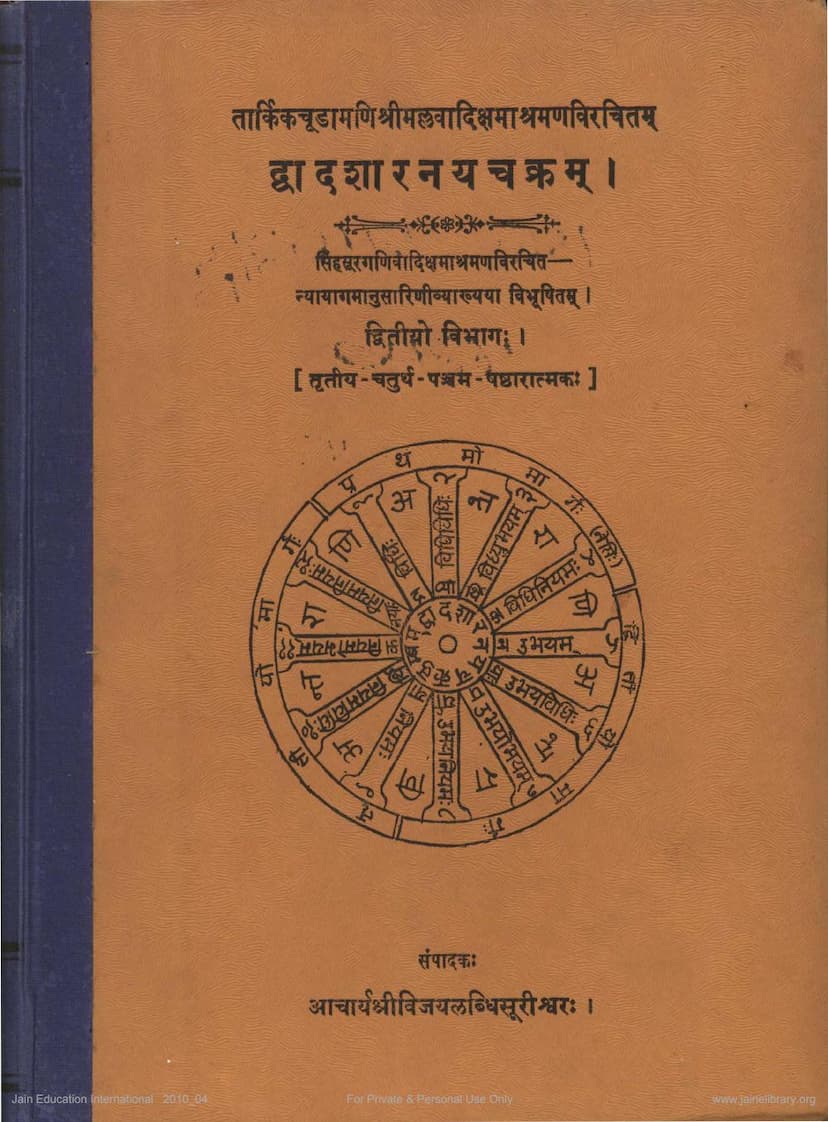Dvadasharnaychakram Part 2
Added to library: September 1, 2025

Summary
Based on the provided text, here is a comprehensive summary of Part 2 of the Dvadasharnaychakram, focusing on the content presented in the text itself and the table of contents:
Dvadasharnaychakram Part 2 Author: Mallavadi Kshamashraman Commentary: Nyayagamanusarini by Simhasuragani Vadi Kshamashraman Editor & Publisher: Acharya Vijay Labdhi Surishwar, Chandulal Jamnadas Shah Catalog Link: https://jainqq.org/explore/002585/1
Overall Scope of Part 2: Part 2 of the Dvadasharnaychakram, as indicated by the table of contents (pages 10-36), covers the "Vidhi-ubhayara" (Third Chapter) and "Vidhi-niyamara" (Fourth Chapter). This section delves deeply into complex philosophical and logical arguments within Jainism, particularly focusing on the nature of reality, the relationship between substance (dravya) and qualities/actions (guna/kriya), and the validity of different epistemological viewpoints (nayavada).
Key Themes and Arguments:
-
Analysis of Different Philosophical Schools: The text engages in a detailed refutation and comparison of various philosophical schools, including those that emphasize:
- Eka-purusha-vada (Monism of Self/Spirit): Arguments against the idea of a single, all-pervading self or spirit as the sole reality.
- Samyudaya-vada (Aggregationalism/Collectivism): Critiques of views that posit reality is merely an aggregate of parts without an underlying substance.
- Kshanika-vada (Momentariness/Impermanence): Refutations of the doctrine that reality is constituted by momentary existence.
- Shunya-vada (Voidism/Nihilism): Arguments against the concept of absolute void or nothingness as ultimate reality.
- Ishvara-vada (Theistic Creationism): Critiques of the idea that a singular God or Ishvara is the sole cause of the universe.
- Karma-vada (Karma as the sole cause): Discussions on the primacy and sufficiency of karma in explaining reality.
- Dravya-artha-naya (Substance-oriented viewpoint): Arguments from the perspective of substance as the ultimate reality.
- Paryaya-artha-naya (Modification/State-oriented viewpoint): Arguments from the perspective of modifications or states as the ultimate reality.
- Vaiyaakarana-mata (Grammatical/Linguistic philosophy): Incorporating insights from grammatical theories to understand philosophical concepts.
-
The Nature of Reality (Dravya and Paryaya): A significant portion of the text is dedicated to exploring the intricate relationship between:
- Dravya (Substance): The underlying, eternal, and unchanging essence of things.
- Paryaya (Modification/State/Accident): The changing, impermanent aspects or states of a substance. The text grapples with whether these are distinct or identical, and how different philosophical schools understand their interaction. The debates often revolve around whether the ultimate reality is one (advaita) or many (dvaita).
-
The Role of Language and Concepts: The text highlights how language, concepts, and logical argumentation (nayavada) are used to understand and articulate reality. The editor's introduction mentions a "Vishamapadavivechana" (Explanation of Difficult Terms), indicating a focus on precise semantic and philosophical analysis.
-
Refutation of Contrasting Views: A core methodology of the text is the systematic refutation of opposing philosophical positions. Mallavadi Kshamashraman, known for his sharp dialectical skills, uses extensive logical reasoning and quotes from other scriptures (e.g., Upanishads, Mahābhāṣya, Buddhist texts) to support his arguments and counter opposing views.
-
The Concept of "Bhavana" (Mental Cultivation/Contemplation): The text delves into the nature of subjective experience and mental states, particularly in the context of distinguishing between different types of cognition and their relation to reality. The concept of "viveka" (discrimination) is central to understanding these distinctions.
-
Specific Debates: The table of contents reveals detailed discussions on specific logical and metaphysical points:
- The relationship between Purusha (Self) and Avasthas (States).
- The nature of Niyati (Destiny/Fate), Kala (Time), Svabhava (Inherent Nature), and Bhava (Existence/State).
- The concept of Sanidhya-bhavana (Co-presence) vs. Apatti-bhavana (Manifestation/Attainment).
- The nature of Prakriti (Primordial Matter) and its relation to Purusha (Consciousness) in Samkhya philosophy, and its critique from a Jain perspective.
- The debate on whether reality is ultimately one (advaita) or many (dvaita).
- The analysis of various Nayavadas (Standpoints/Arguments) within Jain philosophy, such as Dravya-naya, Paryaya-naya, Shabda-naya, and Vigraha-naya.
- The examination of creationist (Ishvara-vada) and evolutionary (Pradhana-vada) theories of the universe.
- The concept of Karma and its role in the cycle of existence (samsara) and liberation (moksha).
Methodology: The work employs rigorous logical analysis, comparative philosophy, and extensive scriptural references to build its arguments. The editor's efforts to collate various manuscripts and provide critical commentary (Vishamapadavivechana) indicate a scholarly approach to presenting complex philosophical doctrines.
In essence, Dvadasharnaychakram Part 2 is a foundational text in Jain logic and metaphysics, engaging in profound debates to establish the Jain worldview by systematically analyzing and refuting alternative philosophical systems, particularly concerning the fundamental nature of reality, causality, and the self.